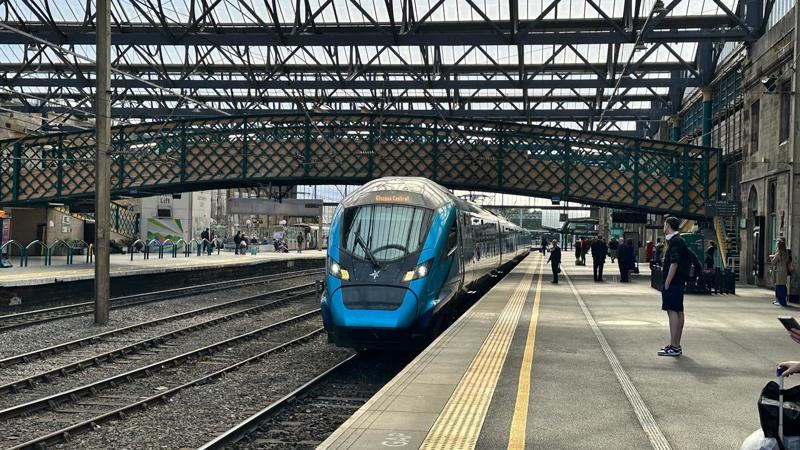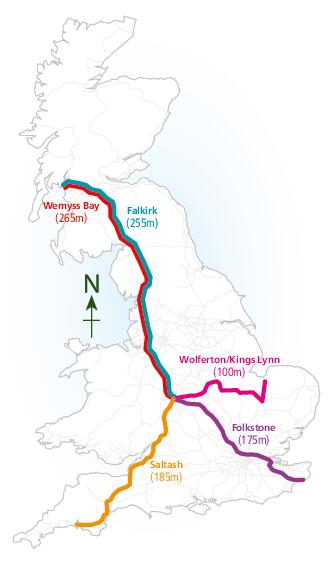Fancy a coffee? In Scotland? All for around £40 return (not including the coffee)? Peter Plisner reports on mad days out by train, made possible by railcards and a handful of split tickets.
In this article:
Fancy a coffee? In Scotland? All for around £40 return (not including the coffee)? Peter Plisner reports on mad days out by train, made possible by railcards and a handful of split tickets.
In this article:
- Unlikely Journeys: Two embark on long-distance day trips from the Midlands, discovering stunning stations and scenic routes.
- Money-Saving Travel: By using railcards and split ticketing, they slash travel costs, turning pricey journeys into affordable adventures.
- Memorable Destinations: From Wemyss Bay to Folkestone and Saltash, each trip combines history, engineering marvels, and unexpected sunny weather.

It might seem strange to travel from the Midlands to far-flung places in a day. But with the right connections, the correct tickets, and great company, it’s certainly doable.
My travelling companion has been Siôr Coleman, a Baptist Minister who (like me) is mad on train travel.
Siôr’s first memorable brush with the railways was on the platform at Bridgnorth station at the age of five, where he thought the end of the world had come when being deafened by the noise of the steam train that had carried him and his family from Shrewsbury.
He admits (as do most people of our age) to enjoying the Reverend Awdry’s Thomas the Tank Engine stories. Ironically, he now lives in a corner of Worcestershire close to the church where Awdry was Curate during the Second World War. The church is close to the Birmingham to Bristol railway, and is credited as being the birthplace of the famous railway stories.
My interest in the railways came not from the din of a steam engine, but from the peacefulness of an upbringing close to a disused line near Cambridge that was, like many, closed by the infamous Dr Beeching in the 1960s. That route was part of the old Varsity Line, now being re-created by East West Rail.
Anyway, back to our mammoth rail trips, which came about after several failed attempts to meet up for a coffee.
Siôr and I had never properly met, but knew of each other through our work at the BBC, where for many years I was a transport correspondent and he was a presenter of religious programmes.
Having been reintroduced to him by my wife, who volunteers for a charity he’s involved with, we got chatting, and Siôr said: “I’m having a bit of a mad day out in April. I’m taking a day trip to Wemyss Bay station. May be a bit too far for coffee, though.”
Not at all, I thought! Who would turn down a trip to Scotland for a coffee?
Siôr had already done the research, and found a combination of tickets that allowed the day trip to happen for just £48 - a relatively small sum when you consider how far we were going.
But getting the bargain fare required the purchase of no less than ten tickets for the return journey.
As anyone who has been to Wemyss Bay will testify, the long journey, swapping tickets and trains, is more than rewarded by the elegance of the station and its stunning glass roof.
Wemyss Bay is situated around 26 miles west of Glasgow, and the station was built to connect with the Clyde Steamer and services to Rothesay.
Designed by James Miller for the Caledonian Railway, it’s a must-see station that is Category A-listed. Although neglected for a time, a major refurbishment scheme carried out jointly by Network Rail, Inverclyde Council and the Scottish government has restored it to its former glory.
Surprisingly, the journey involves just two changes at Birmingham and Glasgow.
But to get the lowest price required five tickets - first from our local station to Birmingham, then to Wolverhampton, and after that to Carlisle and Glasgow. Finally, from there to Wemyss Bay.
Making sure we were using the right portion of the ticket when the train manager came to check them was nerve-wracking enough. But some of the connection times were also pretty anxiety provoking!
It was enough to put even seasoned train travellers off ever doing such a mad thing again, but it’s now become a regular jaunt, including another nail-biting trip even further north (of which more later). Strangely for Scotland, the weather was amazing, helping to show off the station’s glass roof to the full.
For the cheapest tickets anywhere, there are two main tips: railcards and split ticketing.
We both have a senior railcard, but most people can get some form of discount card (or cards) enabling travel with a companion.
Ticketing anomalies left over from British Rail days allow passengers to buy separate legs of a journey, rather than just one ticket. The bonus is that splitting your journey can (and often does) bring big savings.
On many occasions, the bulk of the journey will be on the same long-distance train. Provided it calls at the stations which match your split tickets, it’s fine. One drawback is that you might need to change seats, but that has rarely happened to us.
I first came across the concept around 20 years ago, when I did a report for the BBC on the cheapest way to travel to Manchester on a peak-time train. With split tickets, the price dropped by a half.
Most of the journeys I make with Siôr are long, and therefore peak-time travel is essential. But even on off-peak journeys, there are potentially big savings.
When I was covering the subject on TV, working out a split-ticket journey required a lot of planning and studying the timetable. Now it’s really easy, thanks to a plethora of ticket booking websites and apps that do all the difficult work for you.
Their algorithms don’t always plan the most sensible routeing, so you still need to keep your wits about you. But they do generally find you the cheapest set of tickets, and saving on long journeys can be substantial.
One of our biggest savings was on a trip to the old Harbour Station at Folkestone.
Along with Dover, Folkestone was a vital arrival and departure point for the continental boat train. The station was frequently used during the First World War, where soldiers would disembark for a ship to Flanders. It also hosted the Venice-Simplon Express for a time.
The opening of the Channel Tunnel and the high cost of maintaining the approach to the station (along a lengthy metal viaduct, including a swing bridge) led to its closure in 2008, and it was left derelict.
But more recently it’s been refurbished and turned into a linear park, similar to New York’s famous Highline.
It has been lovingly restored with the curved platforms and signal box still in situ. And judging by the number of people walking around the old station, it seems incredibly popular. Once again, the unexpected sunny weather helped.
The split tickets to Folkestone cost under £40, and for that we were expecting to have to head across London to Charing Cross for a slow train south.
But to our surprise, that price included a breathtakingly fast trip on Southeastern’s Javelin service, which runs along High Speed 1. What a treat!
The lower price was helped by the purchase of five tickets each way - including splitting tickets at Rugby on the way to London.
We even had spare cash for a lunch in a former Baptist Church, now a Wetherspoon’s with a railway connection.
It was named after Sir Samuel Morton Peto, a Baptist who was one of the great railway contractors of the Victorian age. He’s credited with being responsible for laying around 750 miles of railway track in England and more than 2,300 miles globally.
From the far south of England, our next trip took us back up north - again to Scotland, this time to see the famous Falkirk Wheel.
It’s the world’s only rotating boat lift - a marvel of engineering and Scottish Canals’flagship destination. It connects the Forth & Clyde Canal with the Union Canal in a half-turn that takes only five minutes.
Just two split tickets to get there this time, although with quite tight connections, and for only around £45.
Although we missed our connection at Haymarket, because Falkirk has two main stations (Grahamston and High) on separate routes we managed to get to our destination only a few minutes late.
Four hours in Falkirk also allowed a brief visit not just to the famous lock, but also to the Kelpies - two amazing sculptures of horse’s heads.
The journey home was a bit of a nail-biter, though, with the first late train on any of our trips.
Concerned about missing our Avanti West Coast connection heading south, we talked to Aimee the train manager, who said she would make sure that she closed the doors as quickly as possible at the remaining stations to Haymarket. I think she told the driver, as the train seem to brake quite hard at the stops, too.
Our worries about having a possible two-hour layover in Edinburgh, thereby arriving home much later than planned, were unfounded. Helped by Aimee and a slightly late-running Pendolino, we headed south at great speed.
The most recent trip was a mammoth 12 split-ticket return trip to Saltash in Cornwall, to see the Royal Albert Bridge.
This trip was more leisurely than the last, with even a half-hour layover at Cheltenham, allowing us a quick trip to a nearby coffee house.
In addition to the leg from our local station to University and then to Cheltenham, we had tickets from there to Bristol, then to Exeter, then to Tiverton Parkway, next to Plymouth, and finally to Saltash.
This had been a long journey, most of which had been done on one train - a CrossCountry service from Leeds to Plymouth.
Along the way we were treated to spectacular scenes, including waves crashing over the Sea Wall at Dawlish Warren.
Our final train actually crossed Brunel’s masterpiece itself, which spans the River Tamar.
After arrival at Saltash, there was the small matter of a quick selfie on the platform with a view of the bridge, and then lunch in the aptly named Brunel Inn.
I couldn’t resist a quick sit-down on a bench (designed to look like the famous bridge) in the High Street, as we headed off for a walk across the neighbouring road bridge.
We made it home, again mainly on one service and again without any delays. And our next trip in March has already been planned. We’re heading east this time, to Norfolk to see the royal station at Wolferton and hopefully more sunny weather.
Although split ticketing can’t guarantee you won’t get rained on when you arrive (I’m sure it’s going to happen to us at some point), it does offer big savings and a day out like no other. So, go on, grab a friend and start making amazing journeys by train.

For a full version of this article with more images and data, Subscribe today and never miss an issue of RAIL. With a Print + Digital subscription, you’ll get each issue delivered to your door for FREE (UK only). Plus, enjoy an exclusive monthly e-newsletter from the Editor, rewards, discounts and prizes, AND full access to the latest and previous issues via the app.
Login to continue reading
Or register with RAIL to keep up-to-date with the latest news, insight and opinion.


















dr bob - 05/03/2025 09:41
I read "Ticketing anomalies left over from British Rail days allow passengers to buy separate legs of a journey, rather than just one ticket" as a very polite way of saying "The present ticketing system is blatantly dishonest".